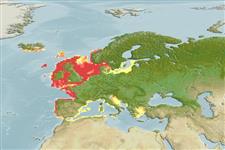Common names from other countries
>
Gadiformes (Cods) >
Gaidropsaridae (Rocklings)
Etymology: Gaidropsarus: Greek, ga, ge = the earth + Greek, ydro = water + Greek psaros = speckled, starling (Ref. 45335).
Environment: milieu / climate zone / depth range / distribution range
Ecologia
marinhas demersal; não migratória; intervalo de profundidade 20 - 120 m (Ref. 35388). Temperate; 64°N - 34°N, 23°W - 27°E
Northeast Atlantic: central Norwegian coast and the Faeroe Islands southwards through the North Sea and around the British Isles to the region around the Straits of Gibraltar. Reported from Iceland (Ref. 12462). Also in the western and northern coasts of the Mediterranean.
Tamanho / Peso / Idade
Maturity: Lm ? range ? - ? cm
Max length : 60.0 cm TL macho/indeterminado; (Ref. 1371); common length : 25.0 cm TL macho/indeterminado; (Ref. 3397)
Espinhos dorsais (total) : 0; Espinhos anais: 0. First dorsal ray followed by a row of small, fleshy filaments. Color is varies from dusky to pale. Fin coloration varies geographically in the Western Atlantic, with southern specimens having more dark blotches than northern ones (Ref. 1371). One barbel on the lower jaw and two on the snout. Large chocolate brown spots on head and body (Ref. 35388).
Found on rocky bottoms but also on mud, sand and gravel. Feed on shrimps, crabs, isopods, small fish, mollusks and polychaetes (Ref. 1371). Spawn during spring and summer in the Mediterranean. Eggs and larvae are pelagic (Ref. 1371).
Life cycle and mating behavior
Maturities | Reprodução | Spawnings | Egg(s) | Fecundities | Larvas
Cohen, D.M., T. Inada, T. Iwamoto and N. Scialabba, 1990. FAO species catalogue. Vol. 10. Gadiform fishes of the world (Order Gadiformes). An annotated and illustrated catalogue of cods, hakes, grenadiers and other gadiform fishes known to date. FAO Fish. Synop. 125(10). Rome: FAO. 442 p. (Ref. 1371)
Categoria na Lista Vermelha da IUCN (Ref. 130435)
CITES (Ref. 128078)
Not Evaluated
Ameaça para o homem
Harmless
Utilização humana
Pescarias: pouco comercial
Ferramentas
Relatórios especiais
Descarregue XML
Fontes da internet
Estimates based on models
Preferred temperature (Ref.
115969): 7.1 - 12.6, mean 9.6 (based on 254 cells).
Phylogenetic diversity index (Ref.
82804): PD
50 = 0.5001 [Uniqueness, from 0.5 = low to 2.0 = high].
Bayesian length-weight: a=0.00490 (0.00304 - 0.00790), b=3.01 (2.87 - 3.15), in cm Total Length, based on LWR estimates for this species & (Sub)family-body (Ref.
93245).
Nível Trófico (Ref.
69278): 3.5 ±0.4 se; based on diet studies.
Resiliência (Ref.
120179): Médio, tempo mínimo de duplicação da população 1,4 - 4,4 anos (tmax=6).
Fishing Vulnerability (Ref.
59153): Moderate vulnerability (44 of 100).
